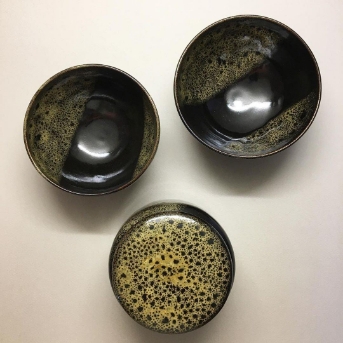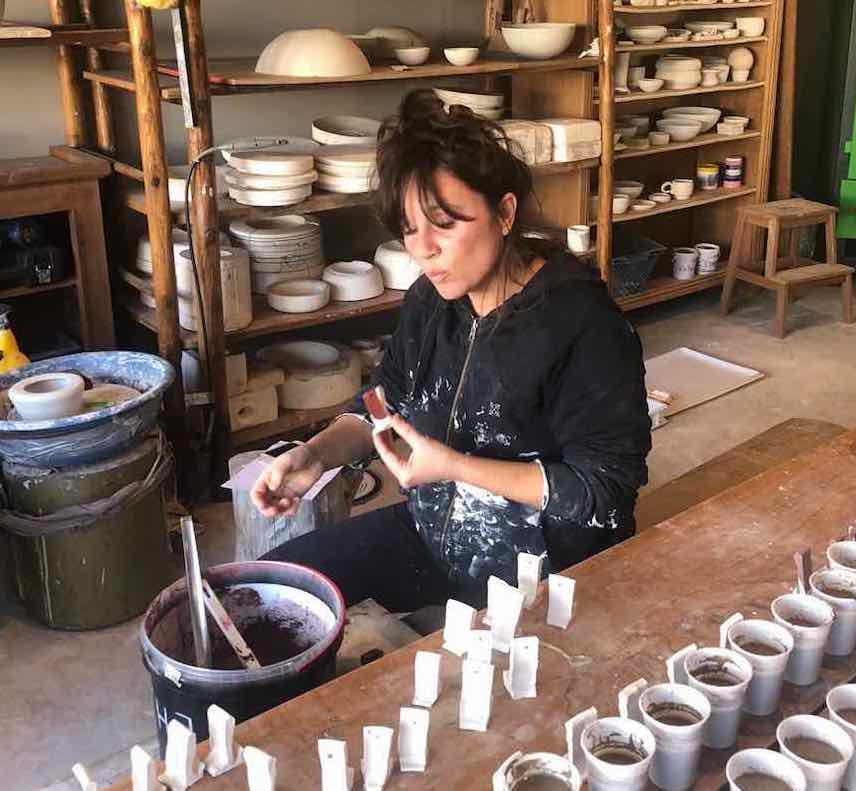BACK-TO-SCHOOL SALE: 40% OFF!
Sale ends soon!
French Master gives you the secrets to Joy and Confidence when the Kiln is opened
Discover what’s causing your pottery defects and how to prevent them using our defect map.
- The 41 page master defect map
- Defect image library to better identify your type of defects
- Access to a community to deepen your knowledge and ask questions
Usual price: $39
Sale price: $19
Online Glazing Course
Learn how to make,
apply and fire glazes
SPECIAL SALE at 40% OFF:
$495 $297
The search for excellence,
at all levels…
Making my own glazes, mastering glazing and then firing my pieces has allowed me to create a unique style and to make a living as a ceramist.
In this online glazing course, I give you the fruits of 40 years of experience. Now it’s your turn to find your own style!
These 12 hours of lessons guide you step by step to get you started in the practice quickly and to approach your glaze research with confidence.
Whether you are an amateur or a professional, mastering the glazing of your pieces will give you the peace of mind you need to boost your creativity and your profits in ceramics!
Matthieu Liévois, potter-ceramist
With this course, you will…
Glazes, the basics – 6h
- Lesson 1 – Understand the chemistry of glazes
- Lesson 2 – Learn to use the research tools of great glaze researchers / Discover the surprising origins of raw materials
- Lesson 3 – Demystify the calculation of glazes and take action!
- Lesson 4 – Master the calculation of glazes / Discover the incredible color palettes of coloring oxides
- Lesson 5 – Start firing. It’s going to get hot!
- Lesson 6 – Discover other glazing techniques and equip yourself to do your own research!
Glazes, advanced – 6h
- Lesson 1 – Understand the role of clay on the rendering of a glaze so you can better work with it
- Lesson 2 – Choose a kiln adapted to your needs!
- Lesson 3 – Play with overlays to create beautiful special effects
- Lesson 4 – Immerse yourself in the world of the major glaze families: examples of specific recipes and tips for using them
- Lesson 5 – Discover the 8 keys to crystallization
- Lesson 6 – Move from technique to work of art, with Matthieu’s crystallizations as an example
Using Glazy
The recipes offered in this course are just a starting point!
You can then explore the infinite possibilities thanks to a free online tool: GLAZY.
Glazy is a recipe exchange site and calculation software.
You can find recipe ideas there and adapt recipes to your products quickly and efficiently, so you don’t have to do mathematical calculations by hand.
But to take advantage of this wonderful tool, it is better to understand the rules of the game!
With the online course, we offer you a complementary lesson to teach you how to use this software.

An online course carefully crafted
by Matthieu Liévois
Potter – Ceramist for over 40 years
“I have been teaching glazing for more than 10 years in my training centre, the Creamik school. But I found that my course materials (texts, books, graphics) were not effective enough, and the scope of my courses was too limited.
That’s why I created this online video course, accompanied by summary PDFs , comprehension questions, and all my recipes.
It took a year of preparation to create these videos using a pedagogical approach that far exceeds what can be done in a book and that has even more benefits than an in-person course.
The proof: my students who are doing professional training are required to watch them.
Nothing like it exists in ceramics!“
1049 students trusted us
Here are some of their work, and their impressions…





The courses are clear and concise: it’s a joy to see Matthieu right in my studio.
Glazing – what a pleasure but what a science!
The courses are essential.
Matthieu also discusses other topics and gives great tips and advice.
I just opened my first two kilns.
A thousand thanks, Matthieu, and bravo.

I realized that it is useful to do the whole course (with the advanced course) even when you are getting started, because there is information that allows you to guide your choices from the beginning.
Matthieu does not make us believe that it is easy; we understand that we have to work, but he gives us the tools and the approach so we do not waste time or go astray.
Matthieu’s technical and artistic mastery opens up many perspectives which can be used in a workshop.
It’s a wonderful course, a dream machine”
Steps to access the online course on glazes:
2.
Complete the online
purchase form:
100% secure
→ You are redirected to your
personal space, where you can
create a password.
Our website has an SSL certificate and secure payment methods to protect your purchase.
3.
Log in
to the online course
Once you have paid for your purchase, find your course in your dedicated space on our site by clicking on:
Enjoy your lifetime access: watch the videos as often as you want,
and download the summary PDFs

We sincerely believe that our online courses
will meet your expectations.
However, to give you peace of mind,
you can request a refund up to 15 days from the date of your purchase.
Frequently Asked Questions
(We also strongly recommend that you watch the videos several times to fully immerse yourself in the content!)
Any additions or improvements to the course in the future are also included in your purchase: you will have access to them without having to pay anything more.
No. No prior knowledge is required to take this course.
The basics course will teach you how to mix glaze powders and how to fire your glazed ceramics.
The advanced course covers, among other things, the influence of clay on glaze, the different types of kilns and the choices you have when buying one. It demonstrates all the techniques for applying glaze to pottery: with a brush, dipping, or using a spray gun. These are important things to consider when purchasing your clay and equipment and are very helpful to know when you are starting out.
The parts of the advanced course that deal with the layering of glazes and crystallization also open up interesting perspectives for you from the start.
You don’t need any prior knowledge of math or chemistry. We offer video reminders that cover everything from A to Z: what is a fraction, a percentage, a cross product in math, a chemical formula, orders of magnitude and even molecular weights in chemistry.
You just have to be willing to learn and let go of that old image of yourself or your high school math classes. The lack of a concrete goal is often the reason someone becomes allergic to math, and today, you have a very good reason to learn it.
You should also know that though we consider it very important to do your first calculations of glazes by hand, so that you understand in depth the steps of creating a recipe, you will not have to calculate each of your glazes for the rest of your life: there is good software for this, and we will show you how to use it.
These glazes are designed by manufacturers to avoid defects. If all goes well, there shouldn’t be any.
But the manufacturer tested their glaze on a specific clay, and the clay has a huge influence on the glaze (as does the kiln, the laying of the glaze, and many other parameters). The manufacturer cannot foresee the variations of all these factors.
If your ceramics come out of the kiln with defects, you can try these adjustments:
=> If the glaze has pimples, you have fired at too low a temperature; fire the next kiln a few degrees higher.
=> If the glaze became runny, you fired too high; fire lower next time.
=> But what if you still have one or the other? What if the clay has influenced the colour, and you’re not getting the hue you were hoping for?
In this case, you will not be able to do anything, because you do not know the composition of the glaze. You will not be able to modify it to solve the problem.
Hence the convenience of making your own glazes: you will be able to control all your parameters and will always be able to rectify the situation when a defect appears.
Yes! Including (more complex) crystallization glazes, if these interest you. Many students have already demonstrated that it is possible!
Of course, like any new skill we learn, it requires commitment, some rigour and training. There will be failures, moments of discouragement and eureka moments. The same goes for wheel-throwing!
– A precision scale for 100g (10€)
– A precision scale for 10kg (80€)
– Small equipment (whisk, sieve, ladle, cups, basins, brushes, etc. ) (140€)
You can therefore get equipped for around 230 euros. (Prices in France. Prices in different countries may vary.)
Yes! We describe each product, with its qualities and its downsides, including the hazards of handling them and the use of glazes when you make dishes that will hold food.
Overall, when it comes to dishes that will be used for food, the main danger is a matter of proportion between the products (the glaze must be impervious to weak acids, such as lemon juice or vinegar in a salad dressing).
In short, at least 3 moles of silica are needed for 0.3 moles of alumina in a formula, so that the glaze can be used for dishes. Don’t worry if you don’t understand this answer; everything is explained in the course…
Suggest that they fire a sample of your clay and your glazes first to give them confidence: low-temperature clay or glaze in a high-temperature kiln can cause significant damage to the kiln. If the potter tries a sample first, they can make sure you have not made a mistake in temperature, without taking any risks for their kiln.
Watching the course before buying a kiln will also allow you to be sure you make the right choice when you purchase one, since an entire video of the course is dedicated to describing the types of kilns, including their advantages and disadvantages.
High-temperature glazes are much easier to make: the lower the melting point of a glaze, the more complex the mixture of products.
It is not impossible to make your own low-temperature glazes, but you usually have to use “frits,” products prepared by manufacturers, which are relatively expensive. As one of the great advantages of making glazes is reducing your costs, using frits loses some of its appeal.
One might choose to make low-temperature glazes because a low-temperature kiln is less expensive to buy. In the long term, this is not a good reason, because low-temperature glazes are much more expensive!





